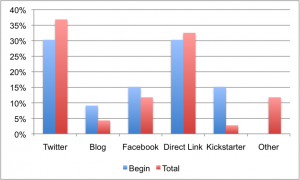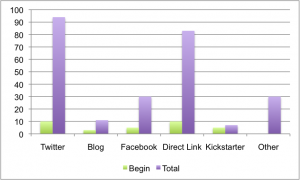Going through our archives, we came across this great post from March 1, 2013,“My Two Answers to Everything” that we wanted to share with you in case you missed it the first time around.
 When our Kickstarter campaign first started, I questioned the impact of social media. Despite being tweeted out by my darling daughter #3, who had over 170,000 followers on twitter, equal numbers of backers came from direct links (that is, people I had emailed directly) and twitter.
When our Kickstarter campaign first started, I questioned the impact of social media. Despite being tweeted out by my darling daughter #3, who had over 170,000 followers on twitter, equal numbers of backers came from direct links (that is, people I had emailed directly) and twitter.
By the end of the campaign, we had 255 backers and had raised over $21,000. If you look at the graph above, you can see that, in the end, compared to how we started out, a higher percentage came from twitter and a much lower percentage from Kickstarter itself. About a third of the “other” category came from radio shows and an ad on an on-line film channel that mentioned our game . The rest of the “other” was a combination of a few MMA sites that had interviewed me recently, and Google (which was the source of only 8 out of 255 backers).
The graph below shows the NUMBER of backers, rather than the percentage, at the beginning and in total.
First of all, twitter turned out to be more important than I had expected in bringing us backers. As the week of Ronda’s fight came, she was on twitter very little, so I assumed her 170,000+ followers would do us little good. Even with a world title fight on her mind, Ronda still tweeted out the link a few times (what a good kid!) Equally important, some early backers became quite interested in the project and re-tweeted links several times.
I thought direct links – me sending email to my friends and family – would be important at the beginning but less so at the end. I was wrong. I have an awesome family. So, although I sent direct links to people I knew and they pledged in the first few days, then THEY sent email to people they knew, who also tended to pledge far more often than people who just happened to see a reference to the project on my blog or some other site. I was a bit surprised by the Facebook results, since I don’t have that many friends on Facebook, but then I realized that some of my younger relatives (and even some of my not-so-younger friends) are on Facebook quite a lot and they shared the link on their pages and their friends did also.
So …. I would say three things were borne out that Kickstarter tells you from the beginning:
- Most crowd-funding is going to come from people you know and people they know. The idea of some viral spreading across the internet where you end up with hundreds of thousands of dollars is probably not going to happen. However, if you get a LOT of support from those close to you, you can be successful.
- It is a LOT of work. My oldest daughter put so much time into it she said, “I would say you owe me your first-born but since that is me, it would just get confusing.”
- The video needs to be short. We put enormous amount of time into making the video. It was a learning experience. I learned that there are not enough drugs in Los Angeles to enable me to tolerate a career in video-editing. Even though we cut our video to 3 and 1/2 minutes, of the 4,153 people who watched it, only 17.3% watched the whole video. (Seriously? You couldn’t watch 3 and 1/2 minutes?) I knew a lot of people didn’t watch it because they would tweet me questions that were answered in the video. Make your video short.
The odds were against us in a number of ways. We wanted to raise $20,000 – the average project raises less than $10,000. According to one published study, a 30-day project of $10,000 has a 35% chance of success. Projects that are featured have an 89% chance of success versus those that are not featured – like us – who have a 30% chance of success. According to the Kickstarter statistics by category, only 33% of game projects get funded. So …. we were not featured, we were above average in the amount we wanted to fund and we were a game. Each of those individually would give us less than a one in three chance of success and the combination, substantially less than that. While Kickstarter features prominently on its page the overall success rate – 44% – if you dig a little deeper, you’ll discover that the success rate may be much lower for your type of project.
Even if you go into it with both eyes open, expecting a lot of work and to just barely make your target – which is exactly what we did expect and exactly what happened – you may still be in for a few surprises. Because we are older than the typical start-up co-founders, more of our friends and family tend to be employed at a fairly good salary. We expected that our average pledge would be higher than typical and it was – $83 versus the average for Kickstarter of $71. Our mode – $50 – was also higher than the mode for the site as a whole – $25. We were a bit surprised that some people who, when we mentioned our project, immediately volunteered that they would back it, some even mentioning large amounts, never backed our project at all.
One thing that helped us greatly in the last week is that we had several larger pledges, but only one came from someone we knew.
Other people pledged far more than we would have asked. We got about what we expected but not really from who we expected it. I thought about this a lot and I finally came to a conclusion. Success in Kickstarter, of course, begins with having a good product. After that, it does not help you to have friends with deep pockets. What helps is to have deep friendships.

